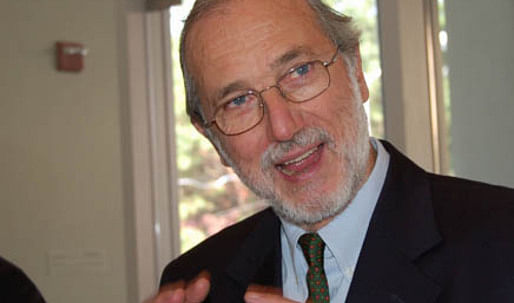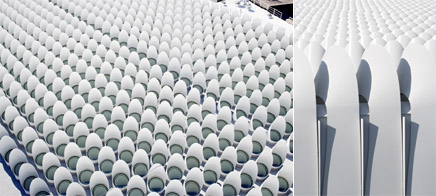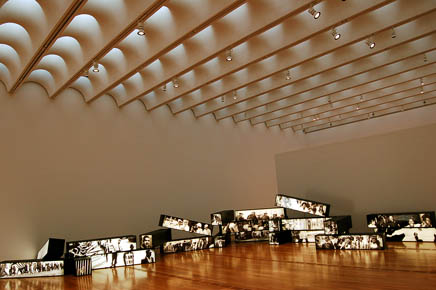

Liz Martin, of LA/Atlanta-based Alloy Projects, talks with Renzo Piano during the opening ceremonies of the new High Museum in Atlanta, Georgia.
LIZ MARTIN: Your father was a builder. How did your childhood influence you in becoming an architect?
RENZO PIANO: When you grow up in a family of builders, you don't worry about what you do when you grow up. It's assumed you will follow in your father's footsteps. I guess it's almost like growing up in the circus, right? Your father is an acrobat and you too have to become an acrobat. It's almost inevitable...The day I went to see my father to say I wanted to become an architect; he was extremely surprised, because for him being a builder is much more than being an architect. He asked me why do you want to be “just” an architect? Well, this is the main reason I call my office is called the Building Workshop.
Above: High Museum of Art, photograph by Jonathan Hillyer 2005. Central piazza surrounded by the Woodruff Center and restaurant Table 1280 (left) the Anne Cox Chambers Wing (center), and the Wieland Pavilion (right). View this and more images in the image gallery
LM: Since you grew up among builders. How did that influence they way you think about craft, materials, and technology?
RP: Architecture is a complex matter, but one continuously present dimension is the craftsmanship and the way you do things and in some way, if you go around the [High Museum] building you can feel it. Everything is well crafted. Every piece is crafted. The building is actually made piece by piece. Everything is designed, tested, made, and re-made. I think this is one of the most essential and inevitable things in architecture.
When I was a young architect, I was devoted to developing objects. I was attracted to the physicality. The piece-by-piece approach was essential to me. Then I began to understand that this is not enough. Architecture is more than just putting things together. It's about the organic, about illusions, a sense of memory, and a textural approach. I must admit, though, that I still love the idea of putting parts together. I love the idea that you go from the general to the detail and then from the detail to the general. It's a double process. You cannot think about the presence of the building in the city without thinking about materiality. And when you think about materiality, you start to think about detail.
LM: What were you trying to achieve in 1977 with the Pompidou Center in Paris?
RP: I did that competition in 1971, together with Richard Rogers, who is one of my best friends, and we are still great friends, when we were very young. I was 33 years. Richard was 36, I guess. We were bad boys. We were really bad boys. And what we wanted to do was mainly to be disobedient to-institution-and build in the middle of Paris. At that time, Paris was full of institutions building that were very, very severe, austere, made of stone-and we wanted to break that sensation of intimidating building. We wanted to create actually a totally different emotion, that is, the one of creating curiosity. Curiosity is a much better emotion than intimidation.
Above: High Museum of Art, photograph by Michael Schwartz of Webwire. View this and more images in the image gallery
LM: The first time I was in Paris, I went to the Pompidou Center and for me, it was the most unique building I had ever seen. What do you think about the current trend for cities to want a signature building? Is this the role of an architect today?
RP: This touches on the ethics of the profession and how we go about our work. I think it's important to note the difference between style and coherence. If you're talking about coherence, I love it. If you're talking about style, then I start to be more suspicious. Coherence is about the experience, about using what you've been learning and reapplying it. It's not simply about making yourself recognizable. Architecture is about exploring. Culturally, historically, psychologically, anthropologically, and topographically, every job is different. So the real risk is that as an architect you end up imposing your stamp before you understand what is the reality of a place. It is not necessarily to integrate with the context. Sometimes architecture should not integrate, but should make a contribution to the context. When dealing with cities, you must employ a homeopathic process instead of surgery, because cities are vulnerable and you can easily destroy their subtle dynamics.
LM: What are your thoughts on the current growth in building new museums?
RP: I love building museums. They are magical places_places where you preserve art, enjoy art, everything becomes durable. There's an invisible net of common feeling around them...The success of today's museum is in some ways very dangerous. Crowds may kill the reason why museums were invented. Enjoying art is a very intimate thing. It's about you and the art. The galleries should be a place of silence.
LM: Recently, you completed the new High Museum complex in Atlanta, Georgia. Tell us about your approach to light and museum design?
RP: It's always a search for north light. The 1,000 skylights at the High Museum are angled because Atlanta is not north-south like Chicago. It's like a sunflower turning toward the light. Natural light is not flat. You feel the day going and the clouds moving. And then there's what I call a Magritte moment. When daylight goes and you start turning on the lights. Light makes the room alive. You should metaphorically take off your shoes when you enter a gallery, which is an intimate relationship between you and the art. It's a place of silence, but the galleries are not neutral. Neutral is an insulting word. A white cube kills art. What we have done here is actually quite active, but at the same time serene.
Above: High Museum of Art, photograph by Michel Denancé. View this and more images in the image gallery
LM: When designing the High Museum buildings, did you struggle with color or just go with the Meier's white?
RP: I always loved Meier's building. It was a dual job””to make the addition and to save [the Meier] from aggression. We needed to keep the scale of the new buildings low. We subdivided the expansion so that it's not one big building, but three. Then we stretched the entire thing to become the campus and we kept the scale balanced. Before, it was a David [the Meier Building] and Goliath [the Piano Buildings]. The bridges make a seamless connection. I hope when people come through the museum, they will forget it is an addition. The same with color. We originally thought of Marmorino panels and when we created mock-ups at the site; it became clear that we needed to paint the building a white like the Meier-designed buildings so the new buildings do not look yellowed or dirty.
Above: High Museum of Art, roof details provided by Renzo Piano Building Workshop. View this and more images in the image gallery
LM: What is your favorite part of your High Museum?
RP: I love standing in the middle of the piazza, turning around and looking in every direction. This sense of urbanity is a universal need. It has nothing to do with Atlanta, Rome, Florence or Paris. I think the invention of the city is a great invention. The city is a place where people get together, and the piazza is an iconic place in the city where difference disappears and where experience melts. People come together with a common desire, a common vision. This is important today, for people of different races and religions. This is universal, nothing to do with Atlanta or somewhere else. It was to do with the human being.
LM: You've often compare architecture to music, and said that architecture, like music, depends a lot on discipline and order. Can you explain how this is incorporated into your design approach?
RP: I wanted to be a musician, but I wasn't good enough so I became an architect...It's really quite theoretical. Music is about order and mathematics. Order and disorder, as well as, discipline and freedom are part of this artistic struggle. Architecture, like music, depends a lot on discipline and order, and then you play that order””which I interpret as setting up frameworks to work within. But sometimes, you must become disobedient to that discipline, and you break the order.
LM: There is a lot of talk about architecture becoming virtual. What is the role of the computer in architecture today?
RP: The computer is essential. When you make a building like the [High] Museum with the 1,000 skylights, or the Tower in Sydney you need a computer to optimize everything. You know, computers are getting so clever that they seem a bit like those pianos where you push a button and it plays the rumba, then a cha-cha and so on. You may play very badly, but you feel like a great pianist. The same is true now in architecture. You may find yourself in the position where you feel like you're pushing buttons and able to build everything. But architecture is about thinking. It's about slowness in some way. You need time to dream. The bad thing about computers is that they make everything run very fast.
Above: High Museum of Art, photograph by Michael Schwartz of Webwire. View this and more images in the image gallery
LM: When you accepted the Pritzker Prize in 1998, you described architects and yourself as explorers. Do you take an idea and rework it or are you always looking for something new?
RP: Every scheme is a new adventure even if you make another museum...that is the reason why you have to be careful not to become self referential””instead of listening to the new place and the new voices you keep promoting your own kind of ego. I don't want to be moralist, but when this happens it is not just bad for architects, it's bad for everybody...So the real risk is that as an architect you end up imposing your stamp before you understand what is the reality of a place. I never take a new job without visiting the place, without trying to understand, without trying to get a basic, fundamental emotion...that truth is the real source of inspiration and if you close yourself in your little gold cage you end up becoming repetitive.
LM: Is there a Renzo Piano style at this point? Is there a signature that if someone came upon a building, didn't know it was yours, would they look at it and say that looks like a Piano?
RP: I think so, but you know, let's put it this way. I don't like the idea that the first preparation, when you start to design, your building has to put your stamp. For example, I love working with very light elements, transparency, and natural light. So when the building's finished, you recognize those elements in some way. But I think imposing your style may be actually very limiting, because you may end by simply imposing your style, instead of understanding the need of people
Throughout her childhood, Liz Martin studied at the Manhattan School of Music, and as a result has always seen the creative process through the eyes of a musician. She edited Pamphlet Architecture 16: Architecture as a Translation of Music, which is now being used as a point of departure for a conference on Architecture / Music / Acoustics in Toronto this summer.
Photographs provided courtesy of Michel Denancé, photographer, Michael Schwartz of Webwire, High Museum of Art, and Renzo Piano Building Workshop.
7 Comments
he thinks, talks and builds very clearly.
no bullshit, great work. i appreciate the messages he sends to architects about being repetetive and imposing style.
great interview, that is about the interviewee and not about the interviewer. thanks to all involved with this archinect feature.
i'd love to see this project some day.
He is probably the most charming of all starchitects....
Click for a multi-media flash component of the above Renzo Piano interview.
http://www.webwire.com/presentations/renzopiano/renzo-piano-gen.html
Great interview!!! Liz Martin who shows us that Piano is a genuinely creative thinker...definitely look at the accompanying audio visual link above by Michael Schwartz.
Wish I was a fly on the wall during this interview. What an opportunity to get into a conversation with Renzo Piano! Love that we can hear him too....check out the multimedia part by Webwire too.
Package deal here!
and at least three on here...
I found my mentor in architecture in term of doing Precedent Studies. You are the one - Renzo Piano, Thank you.
Block this user
Are you sure you want to block this user and hide all related comments throughout the site?
Archinect
This is your first comment on Archinect. Your comment will be visible once approved.